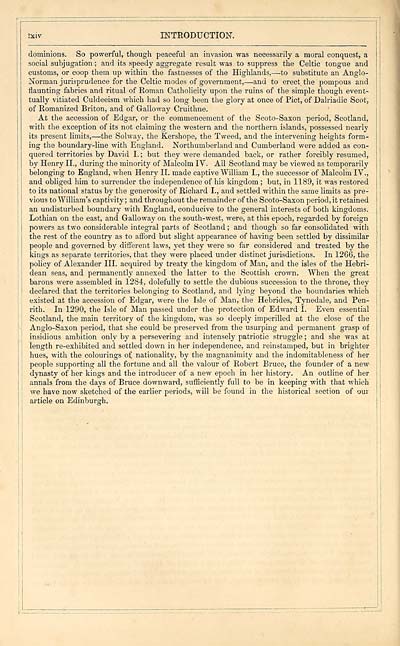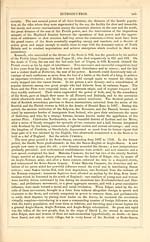Download files
Complete book:
Individual page:
Thumbnail gallery: Grid view | List view

INTRODUCTION.
dominions. So powerful, though peaceful an invasion was necessarily a moral conquest, a
social subjugation ; and its speedy aggregate result was to suppress the Celtic tongue and
customs, or coop them up within the fastnesses of the Highlands, — to substitute an Anglo-
Norman jurisprudence for the Celtic modes of government,— and to erect the pompous and
flaunting fabrics and ritual of Roman Catholicity upon the ruins of the simple though event-
tually vitiated Culdeeism which had so long been the glory at once of Pict, of Dalriadic Scot,
of Romanized Briton, and of Galloway Cruithne.
At the accession of Edgar, or the commencement of the Scoto-Saxon period, Scotland,
with the exception of its not claiming the western and the northern islands, possessed nearly
its present limits, — the Solway, the Kershope, the Tweed, and the intervening heights form-
ing the boundary-line with England. Northumberland and Cumberland were added as con-
quered territories by David I. ; but they were demanded back, or rather forcibly resumed,
by Henry II., during the minority of Malcolm IV. All Scotland may be viewed as temporarily
belonging to England, when Henry II. made captive William I., the successor of Malcolm IV.,
and obliged him to surrender the independence of his kingdom ; but, in 1189, it was restored
to its national status by the generosity of Richard I., and settled within the same limits as pre-
vious to William's captivity ; and throughout the remainder of the Scoto-Saxon period, it retained
an undisturbed boundary with England, conducive to the general interests of both kingdoms.
Lothian on the east, and Galloway on the south-west, were, at this epoch, regarded by foreign
powers as two considerable integral parts of Scotland ; and though so far consolidated with
the rest of the country as to afford but slight appearance of having been settled by dissimilar
people and governed by different laws, yet they were so far considered and treated by the
kings as separate territories, that they were placed under distinct jurisdictions. In 1266, the
policy of Alexander III. acquired by treaty the kingdom of Man, and the isles of the Hebri-
dean seas, and permanently annexed the latter to the Scottish crown. When the great
barons were assembled in 1284, dolefully to settle the dubious succession to the throne, they
declared that the territories belonging to Scotland, and lying beyond the boundaries which
existed at the accession of Edgar, were the Isle of Man, the Hebrides, Tynedale, and Pen-
rith. In 1290, the Isle of Man passed under the protection of Edward I. Even essential
Scotland, the main territory of the kingdom, was so deeply imperilled at the close of the
Anglo-Saxon period, that she could be preserved from the usurping and permanent grasp of
insidious ambition only by a persevering and intensely patriotic struggle ; and she was at
length re-exhibited and settled down in her independence, and reinstamped, but in brighter
hues, with the colourings of nationality, by the magnanimity and the indomitableness of her
people supporting all the fortune and all the valour of Robert Bruce, the founder of a new-
dynasty of her kings and the introducer of a new epoch in her history. An outline of her
annals from the days of Bruce downward, sufficiently full to be in keeping with that which
we have now sketched of the earlier periods, will be found in the historical section of our
article on Edinburgh.
dominions. So powerful, though peaceful an invasion was necessarily a moral conquest, a
social subjugation ; and its speedy aggregate result was to suppress the Celtic tongue and
customs, or coop them up within the fastnesses of the Highlands, — to substitute an Anglo-
Norman jurisprudence for the Celtic modes of government,— and to erect the pompous and
flaunting fabrics and ritual of Roman Catholicity upon the ruins of the simple though event-
tually vitiated Culdeeism which had so long been the glory at once of Pict, of Dalriadic Scot,
of Romanized Briton, and of Galloway Cruithne.
At the accession of Edgar, or the commencement of the Scoto-Saxon period, Scotland,
with the exception of its not claiming the western and the northern islands, possessed nearly
its present limits, — the Solway, the Kershope, the Tweed, and the intervening heights form-
ing the boundary-line with England. Northumberland and Cumberland were added as con-
quered territories by David I. ; but they were demanded back, or rather forcibly resumed,
by Henry II., during the minority of Malcolm IV. All Scotland may be viewed as temporarily
belonging to England, when Henry II. made captive William I., the successor of Malcolm IV.,
and obliged him to surrender the independence of his kingdom ; but, in 1189, it was restored
to its national status by the generosity of Richard I., and settled within the same limits as pre-
vious to William's captivity ; and throughout the remainder of the Scoto-Saxon period, it retained
an undisturbed boundary with England, conducive to the general interests of both kingdoms.
Lothian on the east, and Galloway on the south-west, were, at this epoch, regarded by foreign
powers as two considerable integral parts of Scotland ; and though so far consolidated with
the rest of the country as to afford but slight appearance of having been settled by dissimilar
people and governed by different laws, yet they were so far considered and treated by the
kings as separate territories, that they were placed under distinct jurisdictions. In 1266, the
policy of Alexander III. acquired by treaty the kingdom of Man, and the isles of the Hebri-
dean seas, and permanently annexed the latter to the Scottish crown. When the great
barons were assembled in 1284, dolefully to settle the dubious succession to the throne, they
declared that the territories belonging to Scotland, and lying beyond the boundaries which
existed at the accession of Edgar, were the Isle of Man, the Hebrides, Tynedale, and Pen-
rith. In 1290, the Isle of Man passed under the protection of Edward I. Even essential
Scotland, the main territory of the kingdom, was so deeply imperilled at the close of the
Anglo-Saxon period, that she could be preserved from the usurping and permanent grasp of
insidious ambition only by a persevering and intensely patriotic struggle ; and she was at
length re-exhibited and settled down in her independence, and reinstamped, but in brighter
hues, with the colourings of nationality, by the magnanimity and the indomitableness of her
people supporting all the fortune and all the valour of Robert Bruce, the founder of a new-
dynasty of her kings and the introducer of a new epoch in her history. An outline of her
annals from the days of Bruce downward, sufficiently full to be in keeping with that which
we have now sketched of the earlier periods, will be found in the historical section of our
article on Edinburgh.
Set display mode to: Large image | Transcription
Images and transcriptions on this page, including medium image downloads, may be used under the Creative Commons Attribution 4.0 International Licence unless otherwise stated. ![]()
| Gazetteers of Scotland, 1803-1901 > Imperial gazeteer of Scotland, or, Dictionary of Scottish topography > Volume 1 > (78) Page lxiv |
|---|
| Permanent URL | https://digital.nls.uk/97460066 |
|---|
| Description | Volume I: Aan-Gordon. |
|---|---|
| Attribution and copyright: |
|

